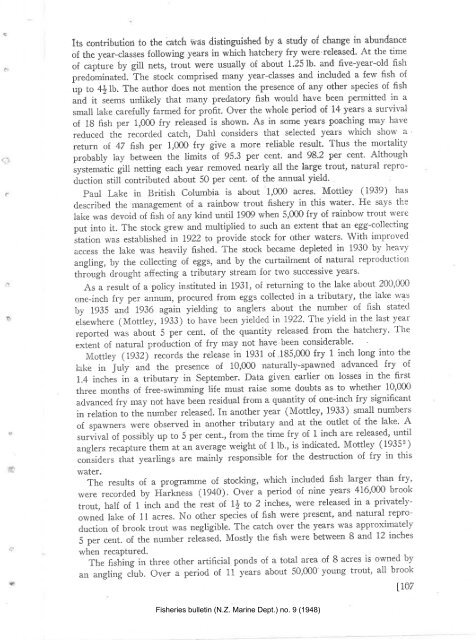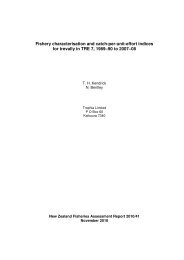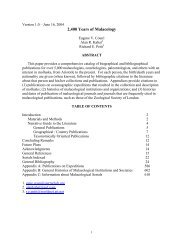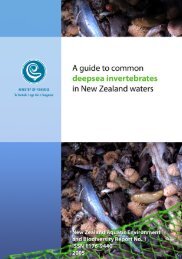- Page 1 and 2:
.ç N.Z. MARINE DEPARTMENT-FISHERIE
- Page 3 and 4:
Ito -il ,A f { I { tIô i N E W ZEA
- Page 5 and 6:
t ta t CONTENTS Part L-Historical I
- Page 7 and 8:
? e CONTENTS-Continued' DNiInonuBNr
- Page 9 and 10:
Plate t, Text LIST OF' ÍLLUSTRATIO
- Page 11 and 12:
PART I Historical INTRODUCTION 1.ur
- Page 13 and 14:
(15)Hitherto,restrictionsonangling,
- Page 15 and 16:
the transference of fish and had to
- Page 17 and 18:
187G80-Releases of brown trout were
- Page 19 and 20:
have been successfully introducecl
- Page 21 and 22:
poltv'ef, alx1 have clisclntgecl wa
- Page 23 and 24:
Reference to forest fires causing h
- Page 25 and 26:
shadowed urater, and that the penet
- Page 27 and 28:
occurred fairly generally, may be n
- Page 29 and 30:
ö drainage has led, it is said, to
- Page 31 and 32:
The existing laws, which are a strr
- Page 33 and 34:
years ago" from the Lee. In 1883 he
- Page 35 and 36:
Orcti Ri 11 (St|. Is.) bct¡-een Di
- Page 37 and 38:
eaches of the Oreti the fish were o
- Page 39 and 40:
iÀr River !Vaipa.hi ....'. tt Slia
- Page 41 and 42:
N) \o River Lure Period 1880-18m' 1
- Page 43 and 44:
CHA}{GE I}f SIZE OF TROUT-SOUTH ISL
- Page 45 and 46:
fr) River Lure Period 1880-1890 189
- Page 47 and 48:
(¡ of sorle inadequacy of specific
- Page 49 and 50:
fallen in inverse proportion to the
- Page 51 and 52:
without a corresponding decrease 'o
- Page 53 and 54:
the Waipahi, increase in numbers bu
- Page 55 and 56:
\iVhile the number of anglers has i
- Page 57 and 58:
cent. in the smaller east and west
- Page 59 and 60:
Data from the special licensing are
- Page 61 and 62:
(Above) I)rought conditions at Quad
- Page 63 and 64:
PART II Recent Management of Fisher
- Page 65 and 66:
important sources of income in the
- Page 67 and 68:
v aim 'is solely one of transfer, i
- Page 69 and 70:
the same as the number of eggs stat
- Page 71 and 72:
û Exclusive of Taupo and Rotorua t
- Page 73 and 74: handled where eggs are collected, a
- Page 75 and 76: Í- stage.Subsequentlosses,aSgivenl
- Page 77 and 78: L The reports of the Ballarat Fish
- Page 79 and 80: J be seen, when abnormal losses are
- Page 81 and 82: '] as -to losses in two lots of bro
- Page 83 and 84: 715,000 fish distributed. This numb
- Page 85 and 86: which those estimates were based an
- Page 87 and 88: CONSTRUCTION OF SPAWNING REDDS OF B
- Page 89 and 90: A con-iparison of losses recorded i
- Page 91 and 92: to time, abnormal flooding, occurri
- Page 93 and 94: It .n,otrlcl appear fronr the facts
- Page 95 and 96: 'I'he fìoocl-trrcached rack in thc
- Page 97 and 98: oclies has been devotecl to recorcl
- Page 99 and 100: In 1935, which was a peak collectin
- Page 101 and 102: of the examìnation ol 2,883 birds
- Page 103 and 104: stations in the country in a year.
- Page 105 and 106: fry of rainbow trout recorded as re
- Page 107 and 108: Ë eggs. The "bag" of the other rvh
- Page 109 and 110: (t seasons, have used stationary li
- Page 111 and 112: t PART III Recent Investigational W
- Page 113 and 114: LAKE ALEXANDRINA_SOUTH CANTERBURY O
- Page 115 and 116: TABI-E XIX Duration of Species Size
- Page 117 and 118: ti 't becoming available. The short
- Page 119 and 120: - is nothing to srlggest that any s
- Page 121 and 122: S-inch fingerlings can be pr:oducec
- Page 123: -ì has shown that the estimated to
- Page 127 and 128: Discussion The various overseas stu
- Page 129 and 130: there are fundamental biological re
- Page 131 and 132: lnanagement to leave well alone anc
- Page 133 and 134: f of the lakes, where, in the absen
- Page 135 and 136: RIVER POLLUTION-Thc photographs ill
- Page 137 and 138: If man is to improve the fertility
- Page 139 and 140: excess, but to the quantity of t.he
- Page 141 and 142: with incligenons forms only where t
- Page 143 and 144: -È-' e tial increase of trout. Con
- Page 145 and 146: here. At present, it is justifiable
- Page 147 and 148: t- of fish from streams. Under tr)r
- Page 149 and 150: Setti;rg an cel baskct u'hcrc it is
- Page 151 and 152: It will be observed from the forego
- Page 153 and 154: d as the present v/fiter has on the
- Page 155 and 156: Environment Improvement-Physical LI
- Page 157 and 158: (3) \A/here the deficiency of cover
- Page 159 and 160: esselltial. Because, r,vith excessi
- Page 161 and 162: ,.) in rivers of considerable size
- Page 163 and 164: ( 1) The relative al,seuce of angle
- Page 165 and 166: !r'i11 not necessarily be the optim
- Page 167 and 168: fo¡gariro lìivcr-Iì¿unous rainL
- Page 169 and 170: ¿> lin,it to llin. would result in
- Page 171 and 172: egulations can have no general sign
- Page 173 and 174: tìature of this iure nc¡r the rno
- Page 175 and 176:
è organization in the provision of
- Page 177 and 178:
larger ones. However, larger societ
- Page 179 and 180:
L G o 4 equitably to obtain a more
- Page 181 and 182:
ç o ç ,) of negative interpretati
- Page 183 and 184:
0 õ o paid in licence fees, can le
- Page 185 and 186:
I ,} o ê REFERENCES Arrrl, K. R. (
- Page 187 and 188:
I Jl f Neeouau, Peur, R., & Slerr*.
- Page 189 and 190:
J I APPENDIX A The 1941 Census of t
- Page 191 and 192:
!L 't ,APPENDIX B Interference with
- Page 193 and 194:
fl tf -ì APPENDIX C Injuries to Tr
- Page 195 and 196:
APPENDIX D Claims of Success of Hat
- Page 197 and 198:
å t.: I -'l t ta ¡ ,} f (3) Cessa
- Page 199 and 200:
maxirnum'density. It is possible al







